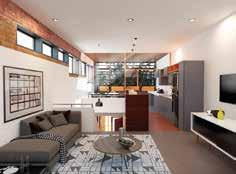
4 minute read
Upbeat about downtown
SPECIAL FEATURE Upbeat about downtown
Property companies are investing in mixed-use precincts.
The Johannesburg CBD is becoming more pedestrian-friendly.
Absa Tower Main, one of Johannesburg’s biggest and most easily identifiable buildings, is undergoing a revamp as one of several ambitious inner-city rejuvenation projects.
Some are purely private in nature, others involve collaboration between developers, NGOs and the City of Johannesburg and its agencies.
A thorough revamp of the Absa building anchors a larger urban revival project that a pedestrian-friendly connection along Fox Street between the Absa campus and the Mabobeng area. To be known as Jewel City, the redevelopment covers six city blocks, five of which have existing commercial buildings on them.
The five commercial buildings will be revamped, and a new residential building will be erected, creating a mixed-use precinct with 20 000m² of commercial lettable space, 4 800m² of retail space and 1 000 residential units.
The partnership created to deliver this project is called the Divercity Urban Property Fund and comprises Atterbury and iThemba Property. The aim is for iThemba to create a further 1 800 housing units within a 2km walking distance of the core of Jewel City, thus creating the kind of density that makes for the easier delivery of services, a bigger market for goods and services, and an allday buzz that purely commercial or retail precincts can’t provide.
Absa Towers Main itself will receive a major upgrade in the course of its conversion to a mixeduse building. Within its 30 storeys, there will be restaurants and coffee shops, childcare facilities and 520 flats in the “affordable” bracket. The space around the building will be transformed into a public park with public art works prominent and links to public transport available. The total value of the investment by Divercity is said to be R2-billion.
Another conscious effort to spark urban revival received support in the way of R2.1-million from
the US Consulate-General. The Johannesburg Inner City Partnership (JICP) submitted its plans to to implement its “Makers Way” project in the Bertrams and Lorentzville suburbs and won approval for its public art project in 2018.
The JICP is involved in numerous partnerships to improve the quality of life in the city.
These include working with the National Association of Social Housing Organisations (NASHO), companies and agencies in the tourism and heritage sectors, urban agriculturalists, banks and financial organisations such as TUHF (Trust for Urban Housing) and AFHCO Holdings, a specialist in inner-city affordable housing developments.
Multiple strategies
Converting industrial properties to housing is another trend associated with the move to densify and improve inner cities. In Braamfontein West, next to the Sontonga Memorial Park, Plitvest and the Izingwe Property Group in association with RichLabs Architects are the developers of Sontonga Lofts. One of the flats is pictured below.
Another active participant in encouraging development in the inner city is the Gauteng Growth and Development Agency (GGDA).
An important nudge for developers has been the tax incentives that accompany the Urban Development Zone (UDZ). The City of Johannesburg and the South African Property Owners Association (SAPOA), have developed a database for properties that fall within the UDZ.

The owner of the plot, valuation and zoning information is available for every stand. Building information is available for some parts of the UDZ.
Various “improvement districts” have also been created, for example the RID (Retail Improvement District) where businesses in a designated area pay levies to secure improved cleaning and security services.
In April 2019 the City of Johannesburg awarded tenders for 24 projects at 84 properties that will see thousands of accommodation options delivered for low-income rental.
The Gauteng Partnership Fund (GPF) has attracted about R3.5-billion in private-sector funding for affordable housing in the province since 2012. The Brickfields housing and rental development in Newton was funded by the GPF and implemented by the Johannesburg Housing Company (JHC) as one of the first inner-city rejuvenation projects. JHC is a leader in converting bad buildings to usable rental space.
The Johannesburg Development Agency (JDA) projects range from the upgrading of Constitution Hill, the Faraday Station precinct, work on the Fashion District and pavements of the inner city, renovation of the Drill Hall and the big Newtown make-over.
Private developer Indluplace Properties has purchased nine large apartment blocks, taking its total buildings in central Johannesburg CBD, Berea and Hillbrow to 23: 33% of the units are bachelor pads, 22% are two-bedroomed flats. The listed company (its major shareholder is Arrowhead) intends to “aggressively grow its portfolio” of high-yielding properties as it believes the rental market has huge potential.
Public spaces play a critical role in urban regeneration planning, as do buildings that serve social purposes. When the Outreach Foundation Community Centre was built in Hillbrow in 2015, it was the first piece of social infrastructure to go up in the suburb since the 1970s. The design, a glass box in a light steel frame which seems to hover over the site, won architects Local Studio the Saint Goban architectural award and provides space for dance and computer classes and offices.










